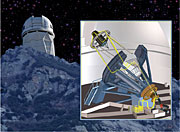- Number 331 |
- February 21, 2011
BigBOSS Advances on Dark Energy

The BigBOSS program
would reach back 10 billion
years to the youthful universe.
BigBOSS is a proposal to use 500 nights of valuable observing time on the National Optical Astronomy Observatory’s (NOAO’s) 4‑meter Mayall Telescope on Kitt Peak to build the biggest-ever galaxy-redshift map of the universe. Using this enormous map, the BigBOSS researchers hope to be able to decide among the leading kinds of explanations of dark energy.
“BOSS” stands for Baryon Oscillation Spectroscopic Survey. In the course of observations over five years, the BigBOSS program would target 50 million objects and find precise locations for almost 20 million galaxies and quasars, reaching back 10 billion years to the youthful universe. The BigBOSS map will encompass 10 times the volume of the current best map of the universe, now being assembled by the Sloan Digital Sky Survey III’s BOSS project, whose first data were released to the world January 11. Both BOSS and BigBOSS are based at DOE’s Lawrence Berkeley National Laboratory.
The BigBOSS collaboration is led by principal investigator David Schlegel and directed by Michael Levi, both of Berkeley Lab’s Physics Division. BigBOSS is nothing if not big, and the Collaboration includes DOE’s Brookhaven National Laboratory, Fermi National Accelerator Laboratory, and SLAC National Accelerator Laboratory, a dozen U.S. universities, and a score of institutions in China, France, Korea, Spain, and the United Kingdom. One member of the Collaboration is the National Optical Astronomy Observatory itself, which recently granted conditional approval to the BigBOSS proposal, pending resolution of technical questions.
Key to the proposal is a modification to the Mayall Telescope that would put an extraordinary new kind of spectrographic instrument in place for use not only by BigBOSS astronomers but indendent researchers as well. The instrument will have a focal plane equipped with robotic positioners to individually pinpoint thousands of astronomical objects and make precision instruments of all of them simultaneously, with the data made available to all astromomers and the public. Funding for the instrument will be sought from DOE and from the parent agency of NOAO, the National Science Foundation, whose final approval of the Mayall Telescope plan would represent a major initial investment.
“Approving BigBOSS to use the Mayall Telescope is the first step toward an ambitious program to explore the expansion of the universe in detail,” says cosmologist Schlegel. “By measuring baryon acoustic oscillation, BigBOSS will study dark energy and can even test whether General Relativity is valid. What’s more, the BigBOSS instrument will give the astronomical community an unprecedented opportunity to make millions of observations for projects not connected to our primary effort.”
Arjun Dey, BigBOSS Collaboration member and NOAO astronomer, says, “BigBOSS will provide a much-needed unique and powerful scientific capability for the venerable Mayall Telescope. Its ability to obtain measurements of nearly 5,000 galaxies or stars simultaneously will enable ground-breaking studies into the nature of dark energy and the structure of our Milky Way galaxy, and will also provide an instrument of unprecedented astrophysical grasp for the U.S. astronomical community. Re-instrumenting and repurposing existing telescopes like the Mayall provide the most cost-effective way of addressing the most important scientific questions of our time.”Submitted by DOE's Lawrence Berkeley National Laboratory
